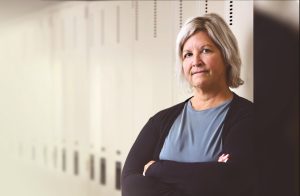By Parkinson Canada
It was late 2013 and Gina Lupino, 36 at the time, slept for three weeks straight, recovering from pneumonia. Gina suspected that something was not quite right with her health, and stiffness, slowness, and ratcheted articulation in her right hand got in the way of playing snare drum in a percussion band. She would see four neurologists over 18 months, and through mostly trial and error, she heard the words, “You have Parkinson’s disease.”
Reducing involuntary movements
A specialist recommended deep brain stimulation (DBS) surgery to improve movement skills and quality of life. DBS is a surgical procedure that involves implanting electrodes that send electrical currents to specific regions in the brain. Batteries are implanted in a patient’s chest like a pacemaker and have to be replaced. This electrical stimulation can reduce involuntary movements and tremors and increase the “on” time where medications are effective.
There are certain risks as well—the most common of these are an infection at the surgical site. Other side effects include nervous system, cardiac or psychiatric disorders.
“One of the things I’ve been looking at is moving to another province just to get this procedure, having to establish residency and a life there. But you can imagine how disruptive that is to my work, to my professional life, to my family,” said Lupino, an intellectual property lawyer specializing in US patent, trademark and copyright prosecution. “I consider myself a poster child for DBS but it could be several years before I am considered—and that window is closing.”
Every day 25 Canadians are diagnosed with Parkinson’s.
Stuck in molasses
“Some days it’s hard to walk, it’s hard to just move. You feel like you’re embedded in molasses,” she adds. Gina is focused on living well with Parkinson’s while awaiting treatment, however. “I work out a lot now and prioritize sleep. My life has changed so much since 2016 and the family now sees that I am thriving,” she says. Lupino considers herself lucky to have her own law practice which gives her the ability to work from home when she is not well or to use speech detect software to write when her right hand does not co-operate.
Her law practice includes a link to research as she works part-time in a national research centre on the UBC campus, helping chemists with intellectual property matters. Some of these chemists produce radioisotopes for Parkinson research. A subtle suggestion from one of these researchers and a formal referral from her neurologist introduced Gina to active participation in Parkinson’s research. When she learned about the work of the Canadian Open Parkinson Network (C-OPN) she signed up as a patient for studies. “Research is for future generations—for me, I try to forget about the future and focus on staying healthy right now,” says Gina.
Hoping for rapid application
The team behind C-OPN sees potential in the collaboration between patients like Lupino and researchers as having potential to unlock the mysteries of Parkinson’s. By participating in the Network, Canadians with Parkinson’s contribute to a national patient registry; a de-identified database and biobank all with the potential to provide data at scale between research centres and to serve the goal of accelerating discoveries in Parkinson’s. More than that Dr. Martin McKeown, a Principal Investigator at the centre that Gina is registered with, sees the opportunity for this information to be applied rapidly to help people within the network today. “We’re now getting into the area of precision medicine, where the therapies might be tailored to the individual. If we can take a heterogeneous condition like Parkinson’s and stratify it into different subgroups who respond similarly to different therapies, knowing what subgroup you were in may guide your clinician into how to tailor the therapy specifically for you,” he says.
From e-parkinsonpost.com
Canadian Open Parkinson Network: Whether for personal benefit or to help future generations, patients collaborating with researchers play an active role in the success of the Canadian Open Parkinson Network. Learn more and join Gina Lupino and hundreds of other early registrants across the country at copn-rpco.ca.














